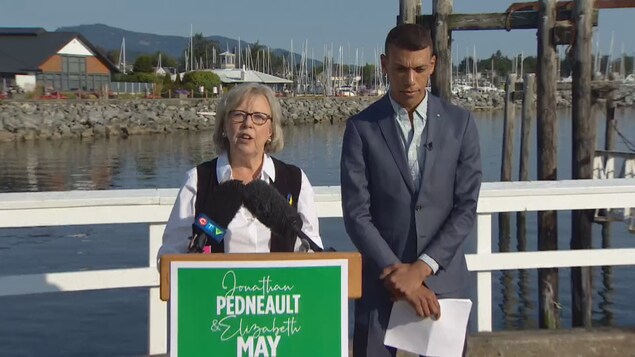Both argued that a shared model of leadership would serve members of the Green Party and Canadian Democracy better than one person leading alone.
This press conference has nothing to do with Elizabeth’s return [May] to save the party or divert the attention of other candidates. It’s about both Elizabeth and I providing the opportunity to use our complementary skills to advance and rebuild the Green Party
said Jonathan Pedneault.
This is a true partnership of equals, an attempt to have a leadership model that better reflects the values of Canada’s Green Party. The boss is not the boss […] it is the members of the grassroots who hold the power
added Elizabeth May.
After 13 years at the helm of the Greens, they gave way in 2019 after a disappointing result in the federal election. However, she retained her seat in the House of Commons as an MP for Saanich-Gulf Islands. There she was re-elected for the fourth time in 2021.
Not do nothing
Elizabeth May explained that reading the recent report by the Intergovernmental Panel on Climate Change (IPCC), which called for significant reductions in fossil fuel consumption and production, contributed to her decision to run again for the party’s leadership.
At the same time, she condemned the government of Justin Trudeau, which, two days after the publication of the report of the IPCCShe says she has given approval for Bay du Nord, a 60-well oil production mega-project off the coast of Newfoundland.
I couldn’t stay idle. […] We have time to avoid the worst and we ignore the opportunity we have because it’s more convenient to pretend we have a plan.
she explained.
Jonathan Pedneault, meanwhile, said he would do politics very seriously
after traveling the world and meeting people whose lives have been changed by history and politics
.
politics […]it’s not a game Too many politicians play politics these days
he complained.
A total of six candidates, including two co-chairs, are running for the presidency of the Greens. The campaign has two rounds. The first, which begins on Wednesday, ends on October 14. Meanwhile, the second round ends on November 19 with the announcement of the results.
A party led by different
David Merner, former Canadian Green Party candidate, is pleased to see the various aspirants at the forefront of the latter. It’s positive, they’re experienced people from all over the country with very different experiences
he said.
He also welcomes the concept of co-nominations. It’s very positive, it exists in Germany, and it’s often a concept of the Greens. It shows that the Greens are run differently, cooperatively
he says.
After a very difficult time for the Greens, he is optimistic about the future.
Sylvaine Zimmerman, a longtime environmentalist in British Columbia, agrees. I like the idea of co-nominations because it’s less about a personality and more about a team
She says.
It’s also in New Zealand and it allows you to do twice as much work because, for example, a leader can stay indoors and he can meet other people.
In this regard, Elizabeth May and Jonathan Pedneault reiterate that it is up to Green Party members to decide during the election campaign how the running mates will divide up the duties and whether they will be elected.
With information from Dominique Lévesque

Avid beer trailblazer. Friendly student. Tv geek. Coffee junkie. Total writer. Hipster-friendly internet practitioner. Pop culture fanatic.



;Composite=(type=URL,url=https://images.radio-canada.ca/v1/assets/elements/16x9/outdated-content-2015.png),gravity=SouthEast,placement=Over,location=(0,0),scale=1)

;Composite=(type=URL,url=https://images.radio-canada.ca/v1/assets/elements/16x9/outdated-content-2016.png),gravity=SouthEast,placement=Over,location=(0,0),scale=1)
;Composite=(type=URL,url=https://images.radio-canada.ca/v1/assets/elements/16x9/outdated-content-2020.png),gravity=SouthEast,placement=Over,location=(0,0),scale=1)
